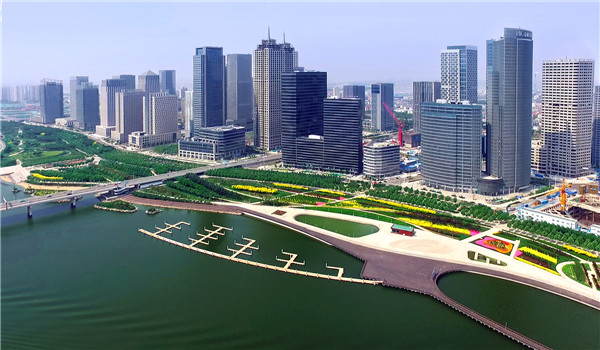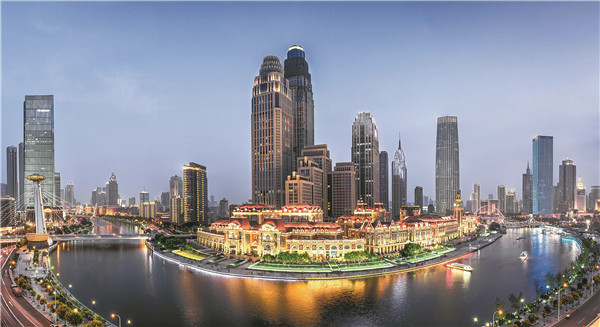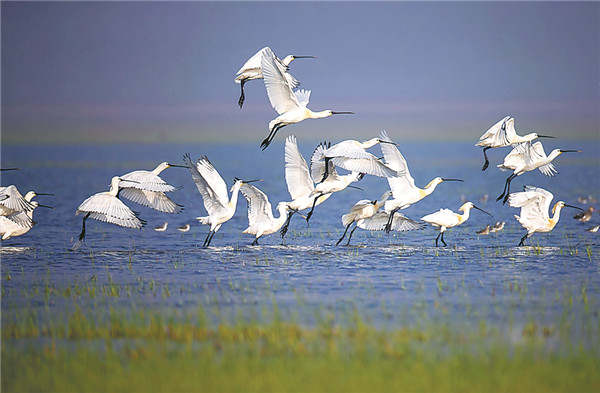Tianjin touts its top business climate, competitive strengths

A park along the Haihe River in a central business district in Tianjin. The city boasts a friendly environment. [Photo/ China Daily]
Port city continues to seek high-quality growth and lead way as major commercial center, Yang Cheng reports.
Known for its unique Chinese and Western architecture, and the relaxed way of life of its citizens, the northern port city of Tianjin is also making steady progress in strengthening its historic position of a hub of business growth. According to some recent reports evaluating Chinese cities' business environments released late last year, Tianjin has climbed higher relative to the progress made by any other city in China.
The city first gained its reputation as a key commercial center in the 19th century and a major trading port both domestically and internationally, and today hosts the Summer Davos in Asia every two years, luring global business champions.
Amid an international trend of shrinking investment, South Korean electronics manufacturer Samsung announced early this year to invest a hefty $2.4 billion in Tianjin, thanks in part to the city's favorable investment climate.
The Tianjin government is making continuous efforts to boost the city's competitive strengths across a range of economic and environmental areas, including artificial intelligence manufacturing, creating an ecological protection belt and playing a pivotal role in the coordinated development strategy of the Beijing-Tianjin-Hebei region.
The city hosts the annual World Intelligence Congress — which plays its part in opening up a new chapter for Tianjin as an industrial center in northern China.

Modern face of Tianjin. The city is advancing the coordinated development of the Beijing-Tianjin-Hebei region. [Photo/ China Daily]
In the past two years, the city has earmarked up to 100 billion yuan ($14.8 billion) toward development in the next-generation AI industry and 10 billion yuan for the technological upgrading of intelligent manufacturing enterprises.
A fund of 30 billion yuan has been set up for the biopharmaceutical sector.
"The government wishes to foster homegrown computing ecology, with an industrial chain that includes the Tianhe-1 and Sugon supercomputers, Phytium central processing unit and Kylin operating system," said a spokesman for the Tianjin Industry and Information Technology Bureau.
Their presence is key in enhancing domestic strength in security and breaking overseas monopolies in the computing sector, industrial experts said.
To sharpen the sector's competitive edge, Tianjin is in close discussions with other market leaders, in a bid to contribute more toward China's homegrown chips, cybersecurity and software.
Many companies are keenly interested in moving to Tianjin, partly because the city is riding high on the tide of China's integrated strategies to boost the coordinated development of the Beijing-Tianjin-Hebei region in North China.
For example, 900 high-tech companies from Beijing have been relocated to the Binhai-Zhongguancun Industrial Park in Tianjin, since November 2016.
Tianjin's Binhai New Area is expected to become an AI industrial hub in the country.
Leading Chinese submarine robot company Sublue, China's first exporter of magnetic levitation or maglev technology to the United States, Emaging, and top drone producer Efy are all prospering in the area.
Business climate
The city itself has beefed up efforts to reduce red tape in support of more private businesses coming to the area.
Last year, eight new policies were released to lower the threshold for private companies in the city, and this January, another 19 policies were added. The policies have significantly helped streamline administrative procedures in business registration and project approval, as well as provide greater scope for funding.
According to statistics, since 2017, Tianjin has slashed taxes for enterprises by up to 105.7 billion yuan, with private investment growing 10 percentage points higher than other investment sources in the city.
A growing number of corporate headquarters and national-level innovation projects have also moved to Tianjin.
According to officials, a batch of high-end industrial and service projects have been set up in the city and more key infrastructure projects have started production.
Despite Tianjin's year-on-year GDP growth in the first quarter of last year being a record low 1.9 percent, since the second quarter last year, its GDP has recovered and seen a steady growth, reporting a yearly rise of 3.6 percent from 2017.
The percentage is expected to rise in 2019, thanks to the city’s support for businesses.
According to a recent survey targeting private companies, Tianjin has risen to No 4 among Chinese cities in terms of its business environment. The survey benchmarked some index made by the World Bank and the All-China Federation of Industry and Commerce to assess the business environment.
The results coincide with China Media Group's survey last year, indicating Tianjin is optimizing its investment and services to embrace global companies.
Their fondness of Tianjin is not only due to the city's huge efforts to boost AI manufacturing, but also the government's resolution to promote businesses and pursue the city's high-quality development.

With its improved environment, Tianjin provides a key stopover for a host of migratory birds. [Photo/ China Daily]
Ecological protection
Tianjin has taken the lead in China in improving its ecological protection.
Since last year, the city has poured in huge investment to build a 736-square-kilometer green protection belt, in a bid to become a "green lung" for the Beijing-Tianjin-Hebei region.
A total of 450 sq km water areas have been designated for ecological preservation in Tianjin, where all forms of economic development are forbidden. The city government has also invested hugely in the protection of the wetlands in Qilihai, Beidagang, Tuanpo and Dahuangbao, which cover a total area of 876 sq km. All the illegal structures in these areas were removed over the past two years.
"Of the nine global bird migration routes, two run through Tianjin," said Mo Xunqiang, a professor with the School of Geographic and Environmental Sciences at Tianjin Normal University.
"Each year, about 2 million birds stop to perch, rest, breed or spend their winter in the northern city," Mo said. "Their numbers are on the rise steadily each year, thanks to the city's environmental efforts.”
Transportation network
For Tianjin, transportation is one of its indispensable advantages, and was key to its century-long business prosperity in the past.
Empowered by AI technology, Tianjin Port, connecting with 500 ports in 180 countries and regions, is expected to see its goods throughput hit 30 million metric tons of equivalent units this year.
The port plays an active role in boosting the coordinated development of the Beijing-Tianjin-Hebei region and in advancing China's proposed Belt and Road Initiative, local officials said.
A traditional industrial center in North China, Tianjin is taking on a new look in the new area, they noted.

Copyright ©
Tianjin Municipal Government. All rights reserved. Presented by China Daily.
京ICP备13028878号-35

